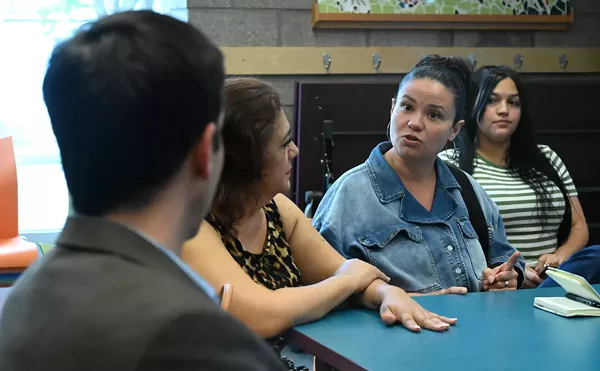Managers at the Denver Post and the Rocky Mountain News value veteran journalists for their experience, their wisdom and their institutional knowledge — and for the way they improve the bottom line when they leave. The Rocky submitted a buyout proposal to longtimers earlier this year, and the Post has presented two go-away deals since 2006. In addition, the Post gave a handful of employees not covered by a Denver Newspaper Guild contract the heave-ho when the latest of its offers failed to generate enough savings.
These moves left dozens of journalists without jobs, including a sizable percentage who were not yet of retirement age — and according to Karen Abbott, who worked at the Rocky for 29 years before splitting in 2006, many of them have expressed anxiety about the future. "I heard them saying, 'I took the buyout, but I don't know how to do anything else. I've worked at a newspaper for thirty years, and I only know how to do this one stupid thing,'" she recalls.
In an effort to aid such folks, Diane Hartman, a former Post features editor who spent twenty years as a spokeswoman for the Colorado Bar Association, and current Rocky staffer and Denver Press Club booster John Ensslin came up with the idea of creating a support group to provide practical tips and advice about transitioning into other careers, as well as a way to keep in touch with suddenly scattered colleagues. Abbott suggested that the collective be dubbed The Jump, "after the newspaper term for the part of the story that's continued on another page," she says — and while Ensslin thought it might be a slow starter, he was wrong. The first two sessions attracted more than twenty people each, and Hartman and company hope an even larger contingent will attend a pre-holiday mixer slated for 6 p.m. Thursday, December 6, at the Press Club, 1330 Glenarm Place (get more information at 303-571-5260 or [email protected].)
The Jump's message is relentlessly positive, but there's still room for a modicum of gallows humor. Retired Post Capitol bureau chief Fred Brown recalls that "one person said, 'Maybe you shouldn't call it The Jump. Maybe you should call it Pushed.'"
That was certainly the case for Todd Engdahl, a member of the Jump board of directors along with Abbott, Hartman, Ensslin, Brown and Peter Blake, a political columnist who accepted a Rocky buyout. Engdahl worked at the Post for more than 31 years in a variety of high-impact roles. For instance, he launched DenverPost.com and subsequently became assistant editorial-page editor. Unfortunately, these appointments were exempt from Newspaper Guild protection, making him vulnerable. In the end, he received the same severance package as did participating Guild employees. The difference? They made the choice to go, while he did not.
Nevertheless, Engdahl wasn't shocked when the hammer came down, and he's not depressed about his circumstances; he's consulting for a couple of local foundations and laying the groundwork for "projects down the road" that he can't announce yet. But he realizes others haven't been so fortunate. "This is a very traumatic time in the traditional commercial print media in Denver," he says, "and something like this, as casual and loose as it is, can still be of help to people who are reeling from the sudden change."
The inaugural Jump event, held in October, focused on transitioning into public relations or public-information-officer gigs — a common destination for individuals with journalism backgrounds, but one that brings some baggage with it. "There's an attitude on the part of some newspaper people that it's slumming to be in PR," Hartman concedes. To dispel this notion, the Jumpers called on Mark Eddy and Lynn Bronikowski, survivors from the Post and the Rocky, respectively, who've reinvented themselves as PR pros. And a November assembly that dealt with job ads brought together more mouthpieces: Andrew Hudson, who once spoke for Mayor Wellington Webb, plus Michelle Ames, another PR type with a Rocky background, and Sharon Sherman, a onetime Poster who presides as managing principal at GBSM, a communications firm.
Will reporters-turned-spokespeople have anyone left to talk to? Abbott says a retired PR expert "who's interested in The Jump for the social aspects" maintained that bloggers might fill the gap, "which was kind of a joke and kind of not." Either way, plenty of younger journalists are departing from the Denver dailies these days, and they often wind up on the same career paths their elders are exploring. Take Mark Couch, a forty-something Post reporter who now gabs for the Colorado Department of Revenue; he'd planned to attend the initial Jump gathering, but it coincided with his going-away party. Although the new job was a major lure, he admits that he was also motivated in part by the tough times facing the print medium. "Denver is an aberration in some ways to have two newspapers going," he allows. "It's hard to say how much longer this area can support both of them."
In the meantime, the dailies are rarely filling vacated positions, and Abbott has heard from numerous staffers feeling overstressed as a result. "They tell me morale is very low," she says. "They complain that the staff is so reduced that everyone is working much harder, and that's very exhausting."
Several Jump attendees remain daily employees but appear to be exploring an exit strategy. Ensslin doesn't fit this category; he sat in on the meetings, but emphasizes that he's very satisfied at the Rocky. Nevertheless, he's pleased to report that a couple of attendees have found employment, and even if The Jump wasn't directly responsible, their accomplishments provide hope to those stuck in search mode. As Hartman points out, "There's certainly life, and work, after journalism."
Letter from the editor: Most media members are very careful about what they put in e-mails to people they don't know, because their comments could wind up anywhere: on a blog, on a message board, in a column like this one. But not long ago, in an exchange with a would-be contributor, R Kelly Liggin, editor in chief of the University of Colorado Denver Advocate, let it rip in an exchange that brims with the sort of snarkiness lotsa editors dream of unleashing.
A few months back, the Advocate inaugurated "Take Your Best Shot," a feature for which readers were asked to send in photographs of interest along with thirty- to fifty-word descriptions. Student Brian Farrell accepted this invitation, snapping what he describes as "a particular piece of art on a concrete support beam that had caught my eye a few months before — a depiction of the self-immolation of a Vietnamese Buddhist monk." When the photo wasn't published, Farrell contacted the paper, and after trading notes with a photo editor, he began to wonder if the submission had been nixed for political reasons. In truth, Liggin says, the quality of the photo wasn't nearly as strong as the subject matter, and after a couple of back-and-forths with an accusatory Farrell, he let his feelings fly.
"While I appreciate your pointed and, frankly, caustic interest in the Advocate, I do not have time for and will not make time for entertaining every crank that has an issue with our issues," Liggin wrote. "If your picture didn't run, it's likely because, for one reason or another, it sucked. Period. Is that a judgment call? Absolutely. Welcome to the publishing business. Those with their names on the masthead make judgment-based decisions. Every single day. If you feel neglected by this process, cope. Meanwhile I have a paper to run. If you need a shoulder to cry on, I invite you from this point forward to take your concerns to my board of advisors. They will not want to hear from you, but there you go."
"Take Your Best Shot" was subsequently discontinued for a lack of interest. "I couldn't even get my friends to send in pictures," Liggin says. "That's how unpopular it was." As for his ultra-direct response to Farrell, Liggin doesn't regret it in the slightest. "I think the attitude was appropriate at that point," he maintains. "I'm sure my advisors would have their own opinions about that, but so long as my name is on the masthead, I'll run the show my way."
Editors everywhere would love to say the same thing.












